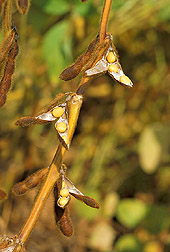This page has been archived and is being provided for reference purposes only. The page is no longer being updated, and therefore, links on the page may be invalid.
Read the magazine story to find out more. |
|
|
Drought-Hardy Soybean Lines with Stamina
By Rosalie Marion BlissNovember 6, 2008
A team led by Agricultural Research Service (ARS) plant geneticist Thomas Carter will soon release advanced soybean breeding lines that carry slow-wilting traits. These lines perform well under drought conditions, and also show good yield potential when rainfall is plentiful. Private seed companies and public soybean breeders can use the drought-tolerant lines as breeding stock to develop high-yielding varieties adapted to stressful U.S. summers.
Carter is with the ARS Soybean and Nitrogen Fixation Research Unit in Raleigh, N.C. "Team Drought" is a group of researchers at five universities, which Carter heads. They aim to develop drought-tolerant breeding lines across a range of maturity groups for adaptation to every soybean-growing area of the country.
The slow-wilting lines yield 4 to 8 bushels more than conventional varieties under drought conditions--depending on the region and environment. For example, where normal soybeans would yield 30 bushels per acre under drought conditions, the slow-wilting types can surpass those yields by about 5 bushels per acre.
Under drought conditions, the typical American soybean crop can drop to a fraction of its yield potential. Adding genetic diversity to the U.S. soybean industry will help protect the food supply from vulnerabilities.
For more than 25 years, Carter has been working on transferring slow-wilting characteristics from Asian landraces, which are foreign "introductions," into U.S.-adapted varieties. As the team gets the slow-wilting trait into high-yielding lines, they share those new lines with industry breeders.
The Team Drought project is funded by ARS and a grant from the United Soybean Board, a group of farmer-directors who oversee investments of the soybean checkoff fund on behalf of all U.S. soybean farmers.
Read more about the research in the November/December 2008 issue of Agricultural Research magazine.
ARS is a scientific research agency of the U.S. Department of Agriculture.

